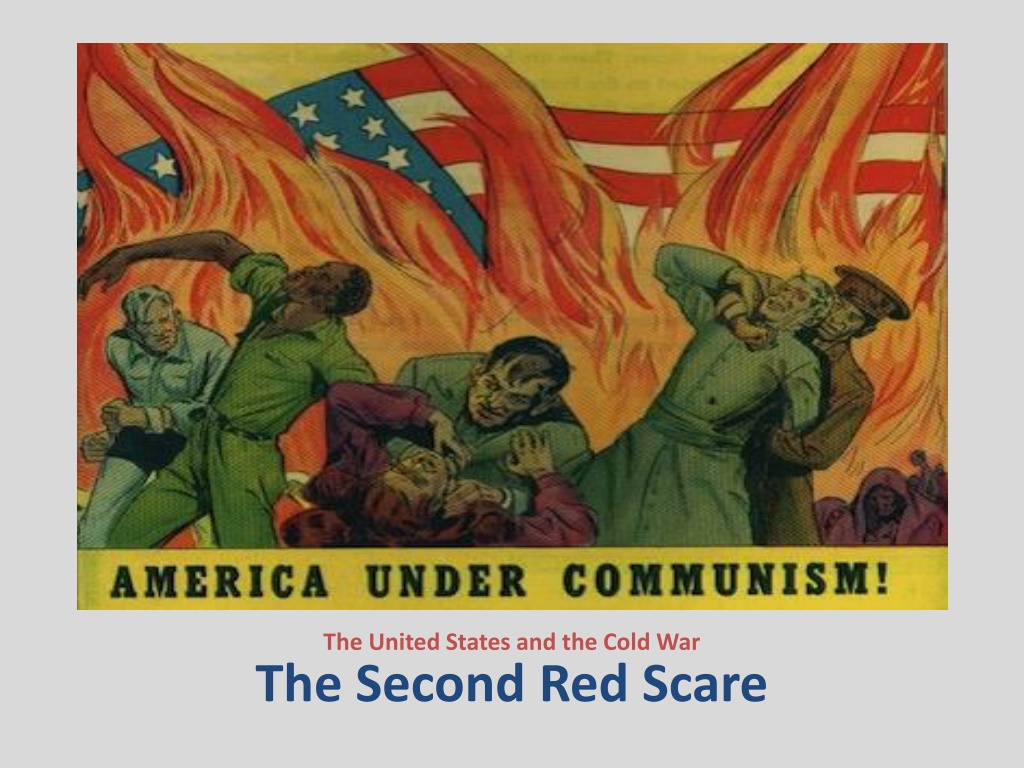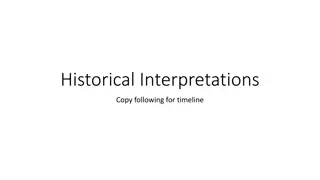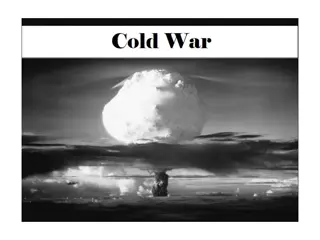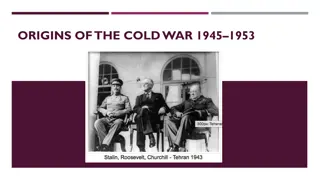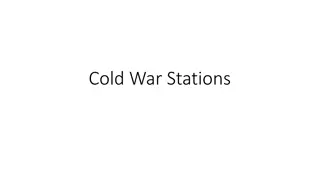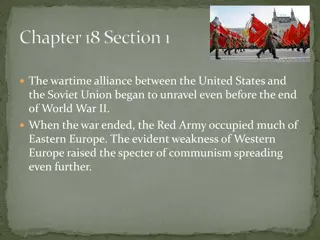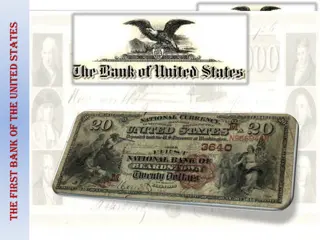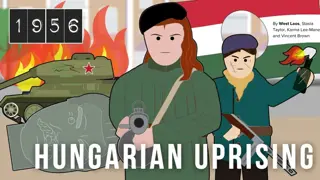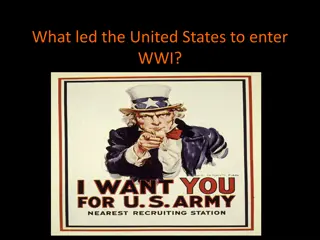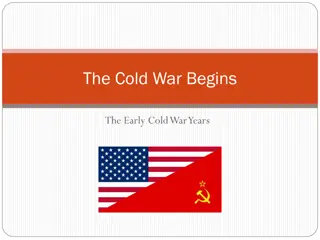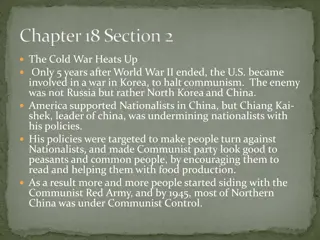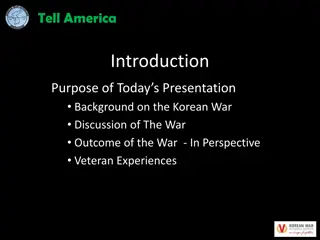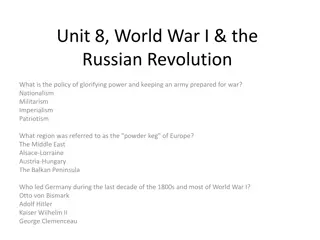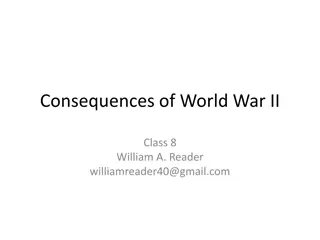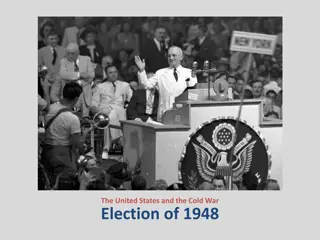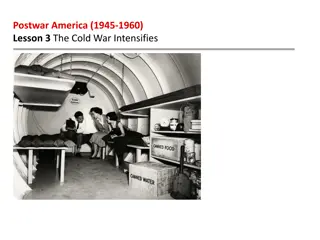The United States and the Cold War: Historical Overview
The content explores the dynamics of the Cold War, focusing on China's internal conflict, the Korean Peninsula division, and the impact of the Second Red Scare in the United States. It delves into the feuds between different factions in China, the rise of communism, the Korean War phases, and the domestic repercussions of anti-communist sentiments in America during that era.
Download Presentation

Please find below an Image/Link to download the presentation.
The content on the website is provided AS IS for your information and personal use only. It may not be sold, licensed, or shared on other websites without obtaining consent from the author. Download presentation by click this link. If you encounter any issues during the download, it is possible that the publisher has removed the file from their server.
E N D
Presentation Transcript
The United States and the Cold War The Second Red Scare
1. What two groups were feuding in China prior to WWII and shortly after? 2. Which nation supported Mao Zedong and the communists? Chiang Kai-shek and Nationalists? 3. What did Mao Zedong promise Chinese peasants? 4. Where were Nationalists forced to flee to following their defeat? 5. Describe why losing China to communism was frightening to Americans? 6. How was the Korean Peninsula divided following WWII? 7. Name the leaders in charge of North Korea and South Korea. 8. Was the Korean Peninsula supposed to remain separated forever? 9. Describe the four phases of the Korean War. 10. How did the United States get involved in Korea? 11. Describe the fallout between President Truman and Gen. MacArthur. REVIEW.
The Second Red Scare Although the presence of the Communist Party in America faded rapidly after World War II, concerns about espionage and communist sympathizers were on the rise. How could politicians use the Red Scare for their own advancement? Republicans? Claimed FDR and Democrats had communist ties. Democrats? Claimed Republicans were linked to Fascism and Hitler. In 1947: President Truman signs an executive order dubbed the Loyalty Order . Granted the Attorney General the right to list Fascist, Communist, and other subversive organizations Of the 13m workers it applied to 14,000 lost their jobs between 1947 and 1953.
Who was targeted during the First Red Scare? When did the United States go through the First Red Scare? QUESTIONS.
The Second Red Scare Was this fear logical? At the height of WWII, about 80,000 Americans claimed membership in the Communist Party. How would the United States respond? Congressman Martin Dies (TX-D) forms the Dies Committee in 1938. Becomes the House Committee on Un-American Activities (HUAC) in 1945.
The Second Red Scare What industry in the US has access to millions of customers through multimedia? Why Hollywood? Most denied ties to communism when interview by HUAC but ten members of Hollywood refused to participate.
The Hollywood Ten Does HUAC violate any constitutional amendments in their questioning? The Hollywood Ten cited First Amendment free speech protection HUAC cited them for contempt and the Supreme Court sentenced all to jail time.
The Second Red Scare Impact of HUAC on the United States? 1. The Blacklist 2. Witch hunts of common people 3. Alger Hiss Case 4. The Rosenberg Case
The Alger Hiss Case The Korean War and advancements in nuclear weaponry by the Soviets promoted the rapid spread of anti-communist sentiment in the United States 1948: Whittaker Chambers accuses Alger Hiss of being part of a Communist group in Washington DC. Hiss Chambers Chambers? A confessed former Communist and TIME magazine editor Hiss? Clerk to Justice Oliver Wendall Holmes Assistant Counsel to the Nye Committee Member of the State Department Went to Yalta with FDR Oversaw the creation of the UN President of the Carnegie Endowment
The Alger Hiss Case What made this case gain national attention? Hiss wasn t a spy, in the words of Chambers, he was an infiltrator. Two days after the accusation by Chambers, Hiss appeared before HUAC and read his opening statement: I am not and never have been a member for the Communist Party. I do not and never have adhered to the tenets of the Communist Party. I am not and never have been a member of any Communist-front organization to the best of my knowledge, I never heard of Whittaker Chambers until 1947, when two representatives from the FBI asked me if I knew him and various other people. I said that I did not know Chambers. So far as I know, I have never laid eyes on him, and the statesmen made about me by Mr. Chambers are complete fabrications.
The Alger Hiss Case After questioning both Chambers and Hiss, Nixon realized it was close to impossible to prove Hiss was a member of the Communist Party. First: Nixon questions Chambers.
The Alger Hiss Case Next: Nixon showed Hiss a photo of Chambers and questioned him.
The Alger Hiss Case Finally: Chambers feared he would be charged with perjury Outcome? Alger Hiss sentence to jail for perjury
The Rosenberg Case The Rosenberg Case (1:40)
The Witch-Hunt - McCarthyism West Virginia in 1950: Senator Joseph McCarthy (WI-R) states the State Department is infested with communists. Claims that he knows of 205 known members of the Communist Party.
